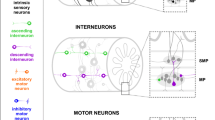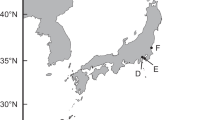Abstract
The crustacean stomatogastric nervous system (STNS) is a well-known model for investigating neuropeptidergic control of rhythmic behavior. Among the peptides known to modulate the STNS are the C-type allatostatins (AST-Cs). In the lobster, Homarus americanus, three AST-Cs are known. Two of these, pQIRYHQCYFNPISCF (AST-C I) and GNGDGRLYWRCYFNAVSCF (AST-C III), have non-amidated C-termini, while the third, SYWKQCAFNAVSCFamide (AST-C II), is C-terminally amidated. Here, antibodies were generated against one of the non-amidated peptides (AST-C I) and against the amidated isoform (AST-C II). Specificity tests show that the AST-C I antibody cross-reacts with both AST-C I and AST-C III, but not AST-C II; the AST-C II antibody does not cross-react with either non-amidated peptide. Wholemount immunohistochemistry shows that both subclasses (non-amidated and amidated) of AST-C are distributed throughout the lobster STNS. Specifically, the antibody that cross-reacts with the two non-amidated peptides labels neuropil in the CoGs and the stomatogastric ganglion (STG), axons in the superior esophageal (son) and stomatogastric (stn) nerves, and ~ 14 somata in each commissural ganglion (CoG). The AST-C II-specific antibody labels neuropil in the CoGs, STG and at the junction of the sons and stn, axons in the sons and stn, ~ 42 somata in each CoG, and two somata in the STG. Double immunolabeling shows that, except for one soma in each CoG, the non-amidated and amidated peptides are present in distinct sets of neuronal profiles. The differential distributions of the two AST-C subclasses suggest that the two peptide groups are likely to serve different modulatory roles in the lobster STNS.



Similar content being viewed by others
References
Audsley N, Matthews HJ, Price NR, Weaver RJ (2008) Allatoregulatory peptides in Lepidoptera, structures, distribution and functions. J Insect Physiol 54:969–980
Blitz DM, Nusbaum MP (2011) Neural circuit flexibility in a small sensorimotor system. Curr Opin Neurobiol 21:544–552
Blitz DM, Christie AE, Coleman MJ, Norris BJ, Marder E, Nusbaum MP (1999) Different proctolin neurons elicit distinct motor patterns from a multifunctional neuronal network. J Neurosci 19:5449–5463
Christie AE (2011) Crustacean neuroendocrine systems and their signaling agents. Cell Tissue Res 345:41–67
Christie AE (2014a) Prediction of the first neuropeptides from a member of the Remipedia (Arthropoda, Crustacea). Gen Comp Endocrinol 201:74–86
Christie AE (2014b) Prediction of the peptidomes of Tigriopus californicus and Lepeophtheirus salmonis (Copepoda, Crustacea). Gen Comp Endocrinol 201:87–106
Christie AE (2014c) Peptide discovery in the ectoparasitic crustacean Argulus siamensis: identification of the first neuropeptides from a member of the Branchiura. Gen Comp Endocrinol 204:114–125
Christie AE (2014d) Identification of the first neuropeptides from the Amphipoda (Arthropoda, Crustacea). Gen Comp Endocrinol 206:96–110
Christie AE (2014e) Expansion of the Litopenaeus vannamei and Penaeus monodon peptidomes using transcriptome shotgun assembly sequence data. Gen Comp Endocrinol 206:235–254
Christie AE (2015) Neuropeptide discovery in Eucyclops serrulatus (Crustacea, Copepoda): in silico prediction of the first peptidome for a member of the Cyclopoida. Gen Comp Endocrinol 211:92–105
Christie AE (2016a) Prediction of Scylla olivacea (Crustacea; Brachyura) peptide hormones using publicly accessible transcriptome shotgun assembly (TSA) sequences. Gen Comp Endocrinol 230–231:1–16
Christie AE (2016b) Expansion of the neuropeptidome of the globally invasive marine crab Carcinus maenas. Gen Comp Endocrinol 235:150–169
Christie AE (2017) Neuropeptide discovery in Proasellus cavaticus: prediction of the first large-scale peptidome for a member of the Isopoda using a publicly accessible transcriptome. Peptides 97:29–45
Christie AE, Chi M (2015) Prediction of the neuropeptidomes of members of the Astacidea (Crustacea, Decapoda) using publicly accessible transcriptome shotgun assembly (TSA) sequence data. Gen Comp Endocrinol 224:38–60
Christie AE, Pascual MG (2016) Peptidergic signaling in the crab Cancer borealis: tapping the power of transcriptomics for neuropeptidome expansion. Gen Comp Endocrinol 237:53–67
Christie AE, Skiebe P, Marder E (1995) Matrix of neuromodulators in neurosecretory structures of the crab Cancer borealis. J Exp Biol 198:2431–2439
Christie AE, Stemmler EA, Peguero B, Messinger DI, Provencher HL, Scheerlinck P, Hsu YW, Guiney ME, de la Iglesia HO, Dickinson PS (2006) Identification, physiological actions, and distribution of VYRKPPFNGSIFamide (Val1-SIFamide) in the stomatogastric nervous system of the American lobster Homarus americanus. J Comp Neurol 496:406–421
Christie AE, Stemmler EA, Dickinson PS (2010) Crustacean neuropeptides. Cell Mol Life Sci 67:4135–4169
Christie AE, Roncalli V, Wu LS, Ganote CL, Doak T, Lenz PH (2013) Peptidergic signaling in Calanus finmarchicus (Crustacea, Copepoda): in silico identification of putative peptide hormones and their receptors using a de novo assembled transcriptome. Gen Comp Endocrinol 187:117–135
Christie AE, Chi M, Lameyer TJ, Pascual MG, Shea DN, Stanhope ME, Schulz DJ, Dickinson PS (2015) Neuropeptidergic signaling in the American lobster Homarus americanus: new insights from high-throughput nucleotide sequencing. PLoS ONE 10:e0145964
Christie AE, Roncalli V, Cieslak MC, Pascual MG, Yu A, Lameyer TJ, Stanhope ME, Dickinson PS (2017) Prediction of a neuropeptidome for the eyestalk ganglia of the lobster Homarus americanus using a tissue-specific de novo assembled transcriptome. Gen Comp Endocrinol 243:96–119
Dickinson PS, Wiwatpanit T, Gabranski ER, Ackerman RJ, Stevens JS, Cashman CR, Stemmler EA, Christie AE (2009) Identification of SYWKQCAFNAVSCFamide: a broadly conserved crustacean C-type allatostatin-like peptide with both neuromodulatory and cardioactive properties. J Exp Biol 212:1140–1152
Dickinson PS, Kurland SC, Qu X, Parker BO, Sreekrishnan A, Kwiatkowski MA, Williams AH, Ysasi AB, Christie AE (2015) Distinct or shared actions of peptide family isoforms: II. Multiple pyrokinins exert similar effects in the lobster stomatogastric nervous system. J Exp Biol 218:2905–2917
Dickinson PS, Armstrong MK, Dickinson ES, Fernandez R, Miller A, Pong S, Powers B, Pupo-Wiss A, Stanhope ME, Walsh PJ, Wiwatpanit T, Christie AE (2018) Three members of a peptide family are differentially distributed and elicit differential state-dependent responses in a pattern generator–effector system. J Neurophysiol (submitted)
Fénelon V, Le Feuvre Y, Bem T, Meyrand P (2003) Maturation of rhythmic neural network: role of central modulatory inputs. J Physiol Paris 97:59–68
Gard AL, Lenz PH, Shaw JR, Christie AE (2009) Identification of putative peptide paracrines/hormones in the water flea Daphnia pulex (Crustacea; Branchiopoda; Cladocera) using transcriptomics and immunohistochemistry. Gen Comp Endocrinol 160:271–287
Harris-Warrick RM, Marder E, Selverston AI, Moulins M (1992) Dynamic biological networks: the stomatogastric nervous system. MIT Press, Cambridge
Hooper SL, DiCaprio RA (2004) Crustacean motor pattern generator networks. Neurosignals 13:50–69
Katoh K, Standley DM (2013) MAFFT multiple sequence alignment software version 7: improvements in performance and usability. Mol Biol Evol 30:772–780
Ma M, Chen R, Sousa GL, Bors EK, Kwiatkowski MA, Goiney CC, Goy MF, Christie AE, Li L (2008) Mass spectral characterization of peptide transmitters/hormones in the nervous system and neuroendocrine organs of the American lobster Homarus americanus. Gen Comp Endocrinol 156:395–409
Ma M, Szabo TM, Jia C, Marder E, Li L (2009) Mass spectrometric characterization and physiological actions of novel crustacean C-type allatostatins. Peptides 30:1660–1668
Marder E, Bucher D (2007) Understanding circuit dynamics using the stomatogastric nervous system of lobsters and crabs. Annu Rev Physiol 69:291–316
Marder E, Christie AE, Kilman VL (1995) Functional organization of cotransmission systems: lessons from small nervous systems. Invert Neurosci 1:105–112
Nusbaum MP, Blitz DM, Swensen AM, Wood D, Marder E (2001) The roles of co-transmission in neural network modulation. Trends Neurosci 24:146–154
Selverston AI (2005) A neural infrastructure for rhythmic motor patterns. Cell Mol Neurobiol 25:223–244
Selverston AI, Ayers J (2006) Oscillations and oscillatory behavior in small neural circuits. Biol Cybern 95:537–554
Selverston AI, Moulins M (1987) The crustacean stomatogastric system. Springer, Berlin Heidelberg
Selverston A, Elson R, Rabinovich M, Huerta R, Abarbanel H (1998) Basic principles for generating motor output in the stomatogastric ganglion. Ann NY Acad Sci 860:35–50
Skiebe P (2001) Neuropeptides are ubiquitous chemical mediators: using the stomatogastric nervous system as a model system. J Exp Biol 204:2035–2048
Stay B, Tobe SS (2007) The role of allatostatins in juvenile hormone synthesis in insects and crustaceans. Annu Rev Entomol 52:277–299
Stein W (2009) Modulation of stomatogastric rhythms. J Comp Physiol A Neuroethol Sens Neural Behav Physiol 195:989–1009
Stemmler EA, Bruns EA, Cashman CR, Dickinson PS, Christie AE (2010) Molecular and mass spectral identification of the broadly conserved decapod crustacean neuropeptide pQIRYHQCYFNPISCF: the first PISCF-allatostatin (Manduca sexta- or C-type allatostatin) from a non-insect. Gen Comp Endocrinol 165:1–10
Thirumalai V, Marder E (2002) Colocalized neuropeptides activate a central pattern generator by acting on different circuit targets. J Neurosci 22:1874–1882
Toullec JY, Corre E, Bernay B, Thorne MA, Cascella K, Ollivaux C, Henry J, Clark MS (2013) Transcriptome and peptidome characterisation of the main neuropeptides and peptidic hormones of a euphausiid: the Ice Krill, Euphausia crystallorophias. PLoS One 8:e71609
Ventura T, Cummins SF, Fitzgibbon Q, Battaglene S, Elizur A (2014) Analysis of the central nervous system transcriptome of the eastern rock lobster Sagmariasus verreauxi reveals its putative neuropeptidome. PLoS ONE 9:e97323
Verlinden H, Gijbels M, Lismont E, Lenaerts C, Vanden Broeck J, Marchal E (2015) The pleiotropic allatoregulatory neuropeptides and their receptors: a mini-review. J Insect Physiol 80:2–14
Wilson CH, Christie AE (2010) Distribution of C-type allatostatin (C-AST)-like immunoreactivity in the central nervous system of the copepod Calanus finmarchicus. Gen Comp Endocrinol 167:252–260
Yan XC, Chen ZF, Sun J, Matsumura K, Wu RS, Qian PY (2012) Transcriptomic analysis of neuropeptides and peptide hormones in the barnacle Balanus amphitrite: evidence of roles in larval settlement. PLoS ONE 7:e46513
Acknowledgements
This study was funded by the National Science Foundation (IOS-1353023 and IOS-1354567), the National Institutes of Health (5P20RR016463-12 and 8P20GM103423-12), the MERITS Program of the Maine Space Grant, the Cades Foundation of Honolulu, Hawaii, and a gift from the Henry L. and Grace Doherty Charitable Foundation to Bowdoin College.
Author information
Authors and Affiliations
Corresponding author
Ethics declarations
Conflict of interest
The authors declare that they have no conflict of interests.
Rights and permissions
About this article
Cite this article
Christie, A.E., Miller, A., Fernandez, R. et al. Non-amidated and amidated members of the C-type allatostatin (AST-C) family are differentially distributed in the stomatogastric nervous system of the American lobster, Homarus americanus. Invert Neurosci 18, 2 (2018). https://doi.org/10.1007/s10158-018-0206-6
Received:
Accepted:
Published:
DOI: https://doi.org/10.1007/s10158-018-0206-6




